How to Fish Wire Through Ceiling Updated
How to Fish Wire Through Ceiling
How to Fish or Run Cables Through Walls and Ceilings
In this DIY how-to guide you will discover out how to fish wire through walls and ceilings easily. Learn how to employ electrical fishing tape or rods to run through ceilings or downward walls in order to elevate new electrical wires back through. As well larn how to observe noggins in walls or ceilings and how to go around them.
1 of the most challenging things about large scale wiring in an existing property, especially large rewire projects is running new cables.
Methods to get around this historic period old issue frequently involve chasing out walls which is a messy and fourth dimension consuming job or running cables in trunking over a walls surface which on the whole completely ruins a finish.
The ideal solution to this trouble is frequently to pull new cables in nether floors and down through stud walls and then in this guide we are going to look at how to fish wire through walls and ceiling and other internal surfaces.
Methods for Running Cables Nether Floors and Through Walls
If you need to run a new electrical cable from one side of a room to another at that place are essentially 2 means to do this; either to fish it through using electricians fish tape or fishing rods or through a crawl infinite.
In terms of electrical fishing tape or rods this detail product is essentially a long thin (around 7 or 8mm diameter) fibreglass pole that is wound effectually a circular cable reel.
A small admission hole is drilled or cut in the location that you want your new cable run to cease and the aforementioned is done at the other end where your cable will be fed from. The fish tape is then pushed through the first hole and through the void in the ceiling or under the floor over to the second hole. The new cable is then attached and pulled through.
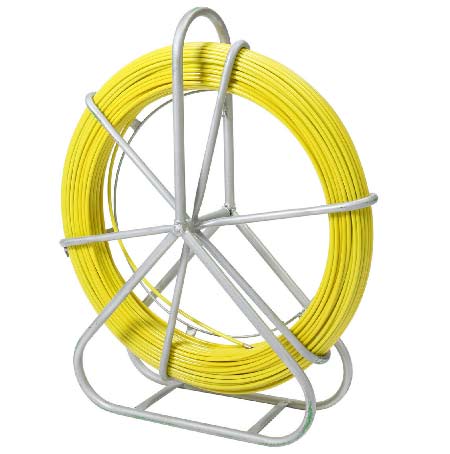
Electricians fish tape on cable reel
The 2nd method is generally reserved for ground floors and too lofts. In some properties that feature a floating timber flooring in that location is oftentimes a gap between the underside of the floor and ground level of sometimes a couple of anxiety.
In these instances information technology's possible to cut a minor hole in the floor and crawl through this space to run your cables. When using this method you lot likewise have to remember to clip your new cables up to the floor joists and not allow them to merely lay on the footing.
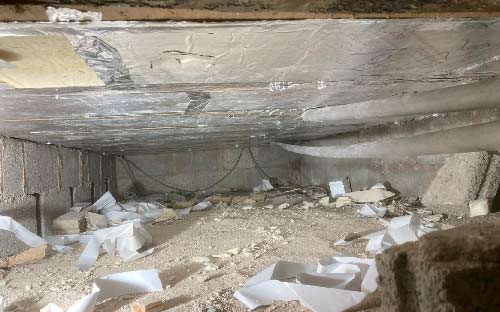
Crawl space under floating timber floor
How to Inspect Floors and Walls
Before nosotros go into the unlike ways of inspecting floor and wall voids it'due south a good idea to expect at why we might want to practice so.
Earlier simply trying to cut and access hole in a flooring or fish a cable through a wall y'all need to know what potential obstructions your are likely to run across that volition hinder your work.
In terms of inspecting there are a few unlike way to bank check what'due south behind walls and under floors, the showtime being to cut a pigsty in the given surface either large plenty to get your caput in so you can accept a look or to cut a smaller pigsty and utilize a small inspection mirror and torch to see what'due south going on in there.
Once you have completed your inspection y'all will then demand to make repairs to the holes that have been created.

Inspection mirror with LED lights platonic for inspecting under flooring and backside walls
The 2nd and arguably best method is to use a modern inspection camera (endoscope or borescope every bit they are also known) that can exist inserted through a tiny ten or 12mm hole that has its own torch and in pretty much all cases skilful quality high definition camera or with new models a 4K photographic camera and fully inspect the void in question in great particular.
Although the top quality cameras of this type are quite expensive and for just 1 inspection chore, not worth the overall outlay (unless you intend to employ it for other projects also) it is possible to yet get cheaper versions that still provide a great quality epitome for equally little as around £thirty.
However if you desire the all-time image possible you tin certainly hire a tiptop quality version from your local hire store for a reasonable daily fee.
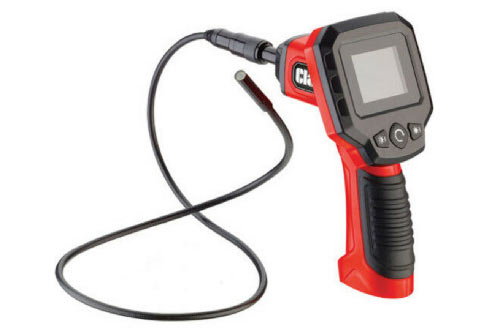
Good quality borescope inspection camera
Requirements for Laying Cables Under Floors and Through Walls
There is only actually one requirement when it comes to pulling or fishing cables nether floors or down through walls and that is that the floor joists or studwork must run in the same direction as you are running the cables.
For example If y'all need to run a new 2.5mm twin and globe from i side of your business firm to the other across its width but afterwards some inspection y'all detect that the floor joists are running length means then yous are non going to be able to physically button the cablevision through the joist, that'due south incommunicable.
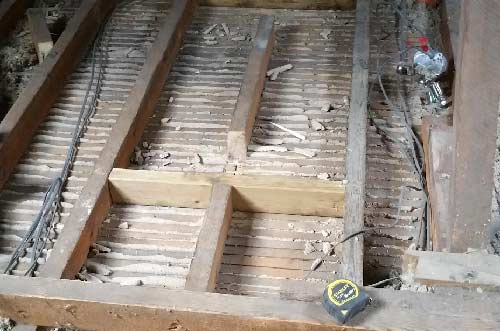
Flooring joist running in reverse way to cablevision management
If nevertheless later on some inspection you can see that the floor joists are running in the same direction that your cable is running then you can easily run your cable downwardly the gap between two joists.
This is too the instance when running a cable down through a stud wall, it'south worth checking kickoff to ensure
What to do About Noggins?
Ane of the principal obstacles you are likely to face when trying to run cables, pipes etc. through walls and under floors or ceilings is the apprehensive noggin.
What is a noggin you lot may inquire? Well a noggin is a small length of timber that runs between 2 parallel flooring or ceiling joists or 2 upright stud timbers that helps to tie a floor, ceiling or wall structure together.
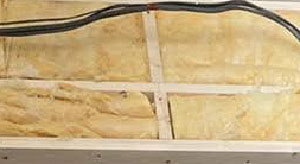
Noggins between ceiling joists
Not only do they assistance necktie a structure together and provide additional force they also provide an additional fixing surface area for ply board, plasterboard or what ever covering the framework is finished with.
There are several techniques for getting effectually noggins, 1 is to use a flexible extension and a apartment dill bit and the other is to cut a department of floor/ceiling out around the noggin, create a notch and pass your fishing tape through the notch.
When using a flexible extension, pop the flat fleck in the finish of the flexible extension and then manoeuvre it downward into the given void and position it in the location you desire to make your pigsty and then attach the other terminate to a drill and drill a pigsty through the noggin.
This technique isn't ideal to be honest and can result in a off-white bit of impairment if the flat bit jumps and skips about inside the wall and is virtually incommunicable to do when working horizontally in a floor or ceiling then it's best to go with the cut out option.
What Nearly Insulation?
If y'all notice that insulation is present in the wall, ceiling or floor you intend to pull your cable through this may indeed scupper your plans of doing and so.
If you are working with a ceiling and Rockwool insulation is present there are sure rules that need to be adhered to when it comes to covering cables in insulation.
If withal y'all are working in a wall or ceiling with solid insulation and so information technology'due south most impossible to actually push button a cablevision or fishing tape through a piece of solid insulation then this is essentially a no get!
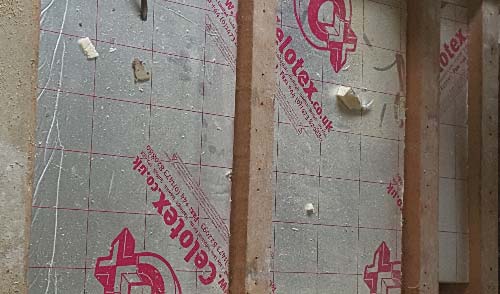
Solid insulation in a ceiling void
Should I get Through the Flooring or Ceiling?
With all of the above in mind before you lot start making any holes anywhere you first need to decide which route is the best to have; through the ceiling or downward through the floor.
This is ultimately a determination as to whether the remedial work to the ceiling after making holes east.g. filling and repairing the hole sand and then re-plastering is going to incur more than hassle or expense than just pulling the floor up.
In nearly cases the ceiling route just edges it all the same if the majority of rooms are empty and so the floor may be the ameliorate option.
How to Run New Cables Through Floors and Walls
For the purposes of this instance nosotros are going to pull a new length of 1mm lighting cable through a ceiling void so that information technology tin exist used to wire a new low-cal. We will be gaining access higher up the void in the loft for our start and exit points but as this is in a property with a loft conversion nosotros simply have limited admission either side.
Create Entry and Exit Holes
The starting time job is to make and entry and exit hole for your fishing tape and cable to run through. Depending on what y'all are working on (flooring, ceiling etc.) and where will depend on how this is done.
In our case equally nosotros are in a loft with a loft conversion nosotros only have a small amount of space in the voids at either side of the loft rooms simply this is only enough to feed our cable through and out.
Equally the whole flooring area was boarded we first had to employ a reciprocating saw to cut a section of the floor away at either side to create enrty and exit points for our cable. A stud, cablevision and pipe detector was first used to cheque for the presence of any cable or pipes.
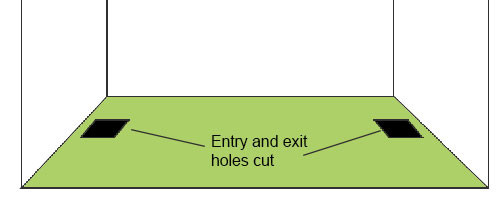
Entry and exit holes created for cable and fishing record
Mark Noggin Positions
To go a cable effectually whatsoever noggins that are present in the ceiling void, the first job is to find out exactly where along your proposed cable run noggins actually reside. To practice this use a stud detector and run it over the proposed cable road on the below ceiling and utilise a pencil or pen to mark the start and end of each noggin along the run.
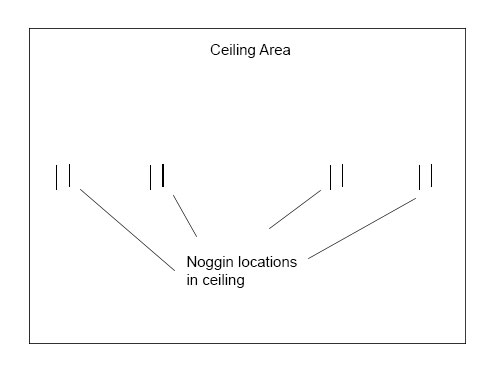
Marking noggins along cable run in ceiling
Next use a pencil and straight edge to marker a rectangle around each gear up of marks roughly 4 inches wide and 10-12 inches either side of the start and finish of the joist, plenty to become a drill in at that place to drill through the joist
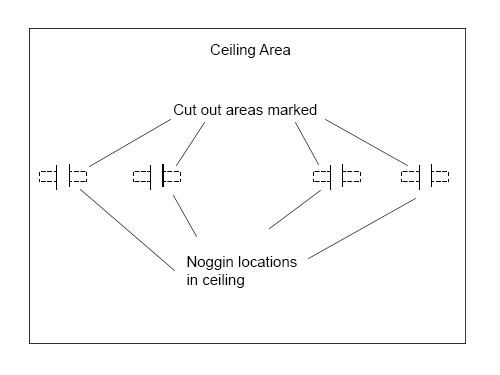
Cutting area marked effectually ceiling joist
Before cutting but check around the marks you made with a pipe and cable detector to ensure there are no pipes or cables running anywhere near your lines and and then employ a plasterboard saw, keyhole saw or a multi tool to gently cutting the rectangle out and then put it to 1 side.
At present, using a pocket-sized cordless drill and the correct sized drill chip for the size of joist or noggin you are working with (see our joist notching project hither for more information) drill a hole through the centre of the joist/noggin.
Repeat the to a higher place process for any remaining noggins simply for any further ones effort to keep them all in every bit directly a line as possible as this will make pulling the cable through much easier
Push Fishing Tape Through
With the holes created in any noggins or joists gently push your line-fishing tape through from your entry hole and wiggle it through the void. Information technology's a great idea to have some extra help at this stage to sentinel the hole and catch the angling tape when it passes over the pigsty. Trying to do this on your own is nigh on impossible.
Once you lot accept a concord of it pass information technology through the hole and on into the other side of the void.
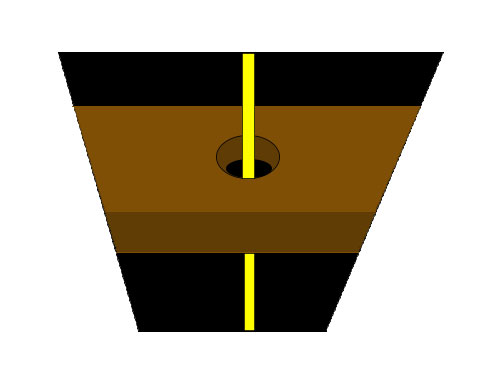
Fishing tape passed through hole in joist
Continue this process until you take passed through all of the holes and your angling tape has reached your exit pigsty.
Equally commented this step is much easier to complete with 2 of yous doing it so go some help!
Adhere Electric Cable and Pull Through
In one case you take bypassed all noggins and your fishing tape has reached the exit hole pull a good few feet through the pigsty.
Side by side attach the cable you desire to draw through the void to the terminate of the angling record. To exercise this beginning strip off a good 6 – 8 inches of the cablevision outer sheath then pair up a skillful vi – eight inches of the cablevision and line-fishing record, spreading the 3 cores of the cablevision evenly effectually the line-fishing tape to reduce any acute edges.
Now record them together using electric tape, ensuring that you fully cover the cease of each cable to create a nice slope to prevent and of the cores from snagging on anything.
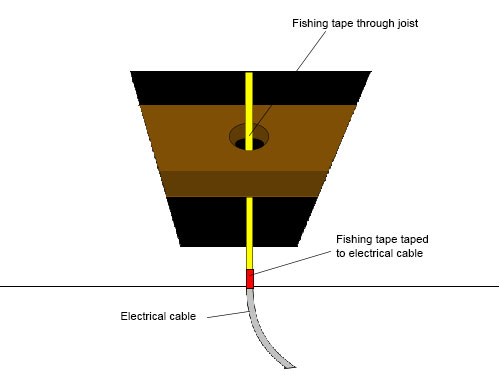
Electrical cablevision taped to finish of fishing tape
With the assist of a helping manus (it's much easier with 2) 1 of you starting time gently start pulling the angling record back through while the other helps to feed the cablevision in. The primal hither is to exist slow and smooth, any hasty actions can cause snags etc.
If you practice experience any snags, gently pull back the opposite way and try again, this normally frees things upward.
Also pay close attending to when the cable reaches the noggin holes every bit one of you volition probably need to aid feed the cable through these sections.
Once y'all have successfully pulled the cable all the mode through get out a good foot or so worth of cable hanging out to foreclose information technology getting pulled back through, this can exist trimmed upwardly later.
Also as you pull through ensure you don't run out of cable! It would be a total nightmare to go to all the attempt of getting the cablevision pulled through just to have it run out and disappear back into the void.
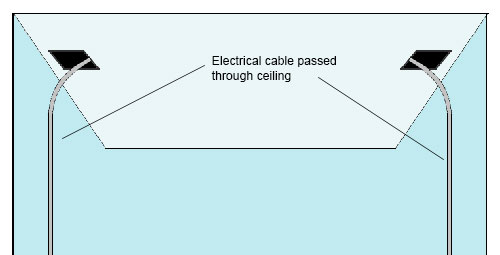
Cablevision successfully pulled through void
Make any Repairs
The final task is to now repair any damage, particularly the holes that you created in your ceiling. This can normally exist done using the sections that y'all cut out earlier.
Only use a plasterboard rasp to tidy up the edges then pop the section back in to the ceiling and screw it in place using plasterboard screws.
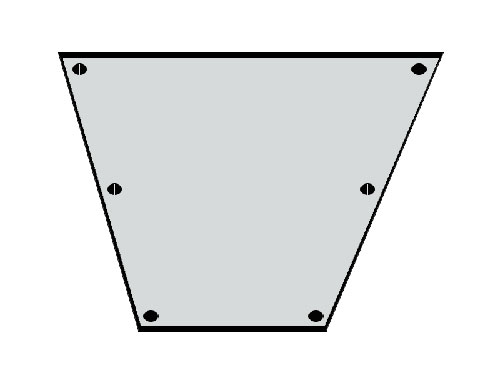
Section of plasterboard replaced in ceiling fix for plastering and finishing
Side by side utilise a suitable filler such every bit Gyproc Easyfill or Everbuild Fill up Once to make full around and over the patch and then let it to fully cure.
Once fully cured use 120 grit sandpaper and a flat sanding cake to sand the area over until it's polish and flush with its surroundings and then paint over it to cease.
Depending on the size and number of holes you have had to cut in guild to drill your holes in the joists, instead of using filler it's well worth getting any repaired patches re-plastered, as plastering will requite pretty much a seamless cease once dried and decorated.
If you need to pull a new length of cable through a ceiling or flooring void or down a wall, using electricians line-fishing record is 1 of the best, quickest and most cost constructive ways of doing this as the only other alternative is really just to rip the floor up or wall downwardly and this is a huge amount of piece of work and expense.
How to Fish Wire Through Ceiling
Posted by: danielhisered.blogspot.com
0 Response to "How to Fish Wire Through Ceiling Updated"
Post a Comment